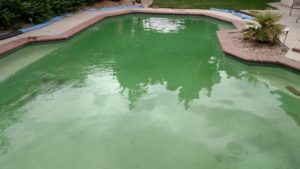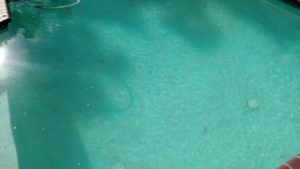Ozone vs. Chlorine
Ozone does not completely replace chlorine, but it does reduce chlorine needs by 80-98% in most pool and spa applications. The most effective sanitizer routine you can enact is with a Corona Discharge Ozonator as your primary sanitizer coupled with small amounts of chlorine. This ensures there is a residual sanitizer in the pool at all times. The dream of a fully non-chlorine pool is attractive, but no chlorine-free pool sanitizer system is reliable against all possible contaminants. Further, a small amount of chlorine will not create the red eye, itch, or swimmer’s asthma that a fully chlorine-based system will. Using an ozone system provides the first line of defense against dangerous contaminants, and chlorine will still be in place as a safety net.
Why Doesn’t the Pool Tech Talk About Ozone?
Chlorine is the traditional way of sanitizing homeowner’s pools in the United States. Ozone, on the other hand, has been used widely in Europe, Canada, and the U.S. in commercial or public pools for many years. Most pool technicians were trained to use chemicals for pool water maintenance and they tend to rely on what they know. Heavy chemical use under the continuous control of an expert can eliminate most dangers and pool techs want this security. But now ozone systems are available that are safe, reliable, and effective. There is no reason to use the complicated chlorine-based sanitizer routines that are prone to getting out of balance.
Keep in mind that chlorine has the following significant drawbacks as a stand-alone pool sanitizer.
• Chlorine is hard to maintain at the proper level, whereas ozone is injected automatically with a proper installation.
• Many recreational water illnesses, like red eye and swimmers itch, are caused by the by-products of chlorine, which are called chloramines. Ozone destroys these by-products to eliminate concern.
• Over time, chlorine is expensive. O3 Science Inc.’s, swimming pool sanitizers will save hundreds of dollars per year in chemical costs for pool users.
• Chlorine reacts with other organics in pool water – like sweat, urine, and other human fluids – and creates dangerous chemicals like nitrogen trichloride and aldehydes. Ozone helps avoid this by replacing a majority of the chlorine, and by oxidizing the organics so the remaining chlorine can do its job much more safely.

What we started with
What is UV? UV light inactivates about 20% – 30% of microorganisms and breaks down chloramines with light energy. This happens while the water is in the UV chamber only, and if the water has no turbidity. It’s also appropriate to note that UV disinfects, whereas ozone will destroy the contaminants completely.
Ozone vs. UV
The two key technologies that form the mainstay of the discussion around secondary disinfection are UV and ozone. Both options have their associated benefits, so the choice in your preferred method should be based on your needs and the associated value you place with each sanitizer.
Comparing Ozone and UV- There is sometimes confusion as to the difference between ozone and UV systems. They are completely different technologies; however, the confusion may stem from UV-generated ozone that was popular in residential pools and spas until the late 1990s when breakthrough compact Corona Discharge ozone generators took over that market. UV generated ozone is never used on a public pool since these systems are incapable of producing enough ozone to benefit the pool water. Corona Discharge generated ozone, on the other hand, is extremely safe and effective for pool water sanitation.
Ozone is dissolved in water to kill microorganisms, destroy organics, and break down chloramines by oxidation. In comparison, UV light inactivates microorganisms and breaks down chloramines with light energy. As mentioned before, this chloramine breakdown only happens while the water is in the UV chamber, and if the water has no turbidity. With Corona Ozone, oxidation occurs immediately at the ozone injection point and continues as the side-stream remixes with the main return. There are no consumables in an ozone system.
While both Corona Ozone and UV provide very effective reduction as documented by third-party testing and validation, there are distinct differences between the two technologies when it comes to other areas of concern for commercial aquatics designers and operators.

After treatment
Ozone vs Salt
Some people enjoy the feel and smell of salty water. However, pool owners are beginning to see that using salt to clean pool water has significant adverse effects.
• Salt generators replace industrial chlorine with locally made chlorine. All chlorine introduced into the pool, by ANY method, makes hypochlorous acid. The problems with chlorine remain, although at a less intense level.
• One important implication of this is that you must maintain the pool chemistry just as carefully with salt generators as with any other form of chlorine – the chemistry balancing act is just as hard with salt.
• Salt creates a disposal problem.
• Salt is corrosive. It will damage hardscapes, surfaces, and other pool parts and components, which will require repair.
Salt Water Pools Are Old News
The saltwater pool fad began in Australia. When the salt chlorinators are working properly (meaning they are properly sized and installed, and regularly cleaned), they can maintain a low level of chlorine in the pool. As a source of residual chlorine, they can function adequately. However, as the primary sanitizer, they also create the negative side effects which were previously mentioned.
Ozone as the Primary Sanitizer
When a pool ozone generator is used as the primary sanitizer, a small amount of Algicide and clarifier at low levels can make for an excellent system without the side effects of high salt and chlorine usage.
